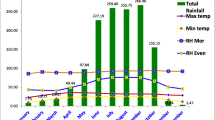Summary
The effects of breed (Friesian, AIS, Sindi-Sahiwal and Jersey), time of day (am v pm) and season of the year (hot or cool) on rectal temperature, pulse rate and respiratory rate were examined in the Highlands and Lowlands of Papua New Guinea. Two types of variation were investigated. Between-cow variation was the basis for the comparison of sites, seasons and breeds. Between-day variation was used to assess the effect of enviromental temperatures on the animal parameters. Respiration rate and rectal temperature appeared more sensitive as indicators of heat stress than pulse rate and using these criteria the highlands climate was suitable for dairy cattle. Jerseys and Sahiwals showed lower respiratory rates compared with Friesians and AIS and their increase in rectal temperature during the day was less than the other two breeds but was not significantly so. The relationships between respiration rate and rectal temperature are discussed.
Résumé
Dans les régions basses et d’altitude de la Papousie-Nouvelle Guinée, on a examiné les effets de la race (Frison, AIS, Sindi-Sahiwal et Jersey), la période du jour (matinée, après-midi), la saison de l’année (chaud ou frais) sur la température rectale, le pouls et le rythme respiratoire. Deux types de variation ont été enregistrés. Les variations de vache à vache ont servi de base pour la comparaison des sites, des saisons et des races. Les variations journalières ont été utulisées pour apprécier l’effet des températures environnantes sur les paramètres des animaux. Le rythme respiratoire et la température rectale semblent être des indicateurs plus sensibles du stress thermique que le pouls. Sur la base de ces critères, le climat d’altitude est plus indiqué pour le bétail laitier. Les jerseyaises et les sahiwals ont montré des rythmes respiratoires inférieurs à ceux des Frisonnes et des AIS; l’augmentation de leur température rectale diurne a été inférieure à celle des deux autres races, sans être pour cela significative. Les relations entre les rythmes repiratoires et le pouls sont discutées.
Resumen
Se estudiaron los efectos de razas (Friesian, AIS, Sindi-Sahiwal y Jersey), hora del dia (am. vs pm.) y estación del año (caliente o fresca), sobre la temperatura rectal pulso y frecuencia respiratoria, en la zona montañosa y baja de Papua, Nueva Guinea. Se investigaron dos tipos de variables. La variable entre-vacas se tomo como base para efectuar la comparación entre sitios (alto y bajo), estación y razas. La variable entre-días se usó para determinar los efectos de la temperatura ambiental sobre parámetros animales. La frecuencia respiratoria y temperatura rectal fueron más sensitivas como indicación del estrés por calor que el pulso. Utilizando estos criterios, se demostro que la zona montañosa era más favorable que la baja para la cria de animales para la producción de leche. Las razas Jersey y Sahiwal presentaron frecuencias respiratorias más bajas que las razas Friesian y AIS y el incremento de la temperatura rectal durante el día fue menor tambien que la de las últimas razas mencionadas, sin ser significativa la diferencia. Se discute la relación entre frecuencia respiratoria y temperatura rectal.
Similar content being viewed by others
References
Allen, T. E., Pan, Y. S. &Hayman, R. H. (1962).Australian Journal of Agricultural Research,14, 580–593.
Amakiri, S. F. &Funsho, O. M. (1970).Animal Production,28, 329–335.
Amakiri, S. F. &Onwuka, S. K. (1980).Animal Production,30, 383–388.
Bandaranayaka, D. D. &Holmes, C. W. (1976).Tropical Animal Health and Production,8, 38–46.
Collier, R. J., Eley, R. M., Sharma, A. K., Periera, R. M. &Buffington, D. E. (1981).Journal of Dairy Science,64, 811–816.
Gwazdanskas, F. C., Wilcox, C. J. &Thatcher, W. W. (1975).Journal of Dairy Science,58, 88–92.
Ingraham, R. H., Gillette, D. D. &Wagner, W. D. (1974).Journal of Dairy Science,57, 476–481.
Maust, L. E., McDowell, R. E. &Hooven, N. W. (1972).Journal of Dairy Science,55, 1133–1139.
McDowell, R. E. (1971). Feasability of commercial dairying with cattle indiginous to the tropics. Cornell International Agricultural Development Bulletin 21.
McDowell, R. E. (1972).Improvement of livestock production in warm climates. W. H. Freeman & Co., San Francisco.
Pan, Y. S., Donegan, S. M. &Hayman, R. H. (1968).Australian Journal of Agricultural Research,20, 395–403.
Turner, H. G. (1984).Animal Production,38, 417–427.
Author information
Authors and Affiliations
Rights and permissions
About this article
Cite this article
Lemerle, C., Goddard, M.E. Assessment of heat stress in dairy cattle in papua new guinea. Trop Anim Health Prod 18, 232–242 (1986). https://doi.org/10.1007/BF02359540
Accepted:
Issue Date:
DOI: https://doi.org/10.1007/BF02359540




